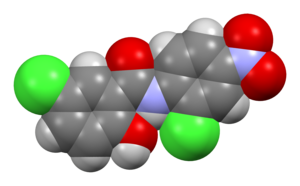Niclosamide
 | |
 | |
| Names | |
|---|---|
| Trade names | Niclocide, Fenasal, Phenasal, others |
| |
| Clinical data | |
| Main uses | Tapeworm[1] |
| Routes of use | By mouth |
| Defined daily dose | 2 grams[2] |
| External links | |
| AHFS/Drugs.com | Micromedex Detailed Consumer Information |
| Chemical and physical data | |
| Formula | C13H8Cl2N2O4 |
| Molar mass | 327.12 g·mol−1 |
| 3D model (JSmol) | |
| Melting point | 225 to 230 °C (437 to 446 °F) |
| |
| |
Niclosamide, sold under the brand name Niclocide among others, is a medication used to treat tapeworm infestations.[3] This includes diphyllobothriasis, hymenolepiasis, and taeniasis.[3] It is not effective against other worms such as pinworms or roundworms.[4] It is taken by mouth.[3]
Side effects include nausea, vomiting, abdominal pain, and itchiness.[3] It may be used during pregnancy and appears to be safe for the baby.[3] Niclosamide is in the anthelmintic family of medications.[4] It works by blocking the uptake of sugar by the worm.[5]
Niclosamide was discovered in 1958.[6] It is on the World Health Organization's List of Essential Medicines.[7] The wholesale cost in the developing world is about 0.24 USD for a course of treatment.[8] It is not commercially available in the United States.[4] It is effective in a number of other animals.[5]
Medical uses
Dosage
The defined daily dose is 2 grams by mouth.[2] For T. saginata, T. solium, or D. latum the dose is 2 grams once in those over the age of six, while in those 2 to 6 years old 1 gram is used, and in those under 2 years old the dose is 500 mg.[1] For H. nana the initial dose is the same, followed by six more days of treatment at half the initial dose.[1]
Side effects
Side effects include nausea, vomiting, abdominal pain, constipation, and itchiness.[3] Rarely, dizziness, skin rash, drowsiness, perianal itching, or an unpleasant taste occur. For some of these reasons, praziquantel is a preferable and equally effective treatment for tapeworm infestation.[citation needed]
Mechanism of action
Niclosamide inhibits glucose uptake, oxidative phosphorylation, and anaerobic metabolism in the tapeworm.[9]
Other applications
Niclosamide's metabolic effects are relevant to wide ranges of organisms, and accordingly it has been applied as a control measure to organisms other than tapeworms. For example, it is an active ingredient in some formulations such as Bayluscide for killing lamprey larvae,[10][11] as a molluscide,[12] and as a general purpose piscicide in aquaculture. Niclosamide has a short half-life in water in field conditions; this makes it valuable in ridding commercial fish ponds of unwanted fish; it loses its activity soon enough to permit re-stocking within a few days of eradicating the previous population.[12] Researchers have found that niclosamide is effective in killing invasive zebra mussels in cool waters.[13]
Research
Niclosamide is being studied in a number of types of cancer.[14] Niclosamide along with oxyclozanide, another anti-tapeworm drug, was found in a 2015 study to display "strong in vivo and in vitro activity against methicillin-resistant Staphylococcus aureus (MRSA)".[15]
Danish biotech company UNION is currently[when?] conducting a clinical study using Niclosamide in the treatment of COVID-19.[16]
References
- ↑ 1.0 1.1 1.2 "Archive copy". Archived from the original on 28 August 2021. Retrieved 1 September 2020.
{{cite web}}: CS1 maint: archived copy as title (link) - ↑ 2.0 2.1 "WHOCC - ATC/DDD Index". www.whocc.no. Archived from the original on 22 January 2021. Retrieved 1 September 2020.
- ↑ 3.0 3.1 3.2 3.3 3.4 3.5 World Health Organization (2009). Stuart MC, Kouimtzi M, Hill SR (eds.). WHO Model Formulary 2008. World Health Organization. pp. 81, 87, 591. hdl:10665/44053. ISBN 9789241547659.
- ↑ 4.0 4.1 4.2 "Niclosamide Advanced Patient Information - Drugs.com". www.drugs.com. Archived from the original on 20 December 2016. Retrieved 8 December 2016.
- ↑ 5.0 5.1 Riviere, Jim E.; Papich, Mark G. (13 May 2013). Veterinary Pharmacology and Therapeutics. John Wiley & Sons. p. 1096. ISBN 978-1-118-68590-7. Archived from the original on 10 September 2017.
- ↑ Mehlhorn, Heinz (2008). Encyclopedia of Parasitology: A-M. Springer Science & Business Media. p. 483. ISBN 9783540489948. Archived from the original on 2016-12-20.
- ↑ World Health Organization (2019). World Health Organization model list of essential medicines: 21st list 2019. Geneva: World Health Organization. hdl:10665/325771. WHO/MVP/EMP/IAU/2019.06. License: CC BY-NC-SA 3.0 IGO.
- ↑ "Niclosamide". International Drug Price Indicator Guide. Archived from the original on 10 May 201. Retrieved 1 December 2016.
- ↑ Weinbach EC, Garbus J (1969). "Mechanism of action of reagents that uncouple oxidative phosphorylation". Nature. 221 (5185): 1016–8. doi:10.1038/2211016a0. PMID 4180173.
- ↑ Boogaard, Michael A. Delivery Systems of Piscicides "Request Rejected" (PDF). Archived (PDF) from the original on 2017-06-01. Retrieved 2017-05-30.
- ↑ Verdel K.Dawson (2003). "Environmental Fate and Effects of the Lampricide Bayluscide: a Review". Journal of Great Lakes Research. 29 (Supplement 1): 475–492. doi:10.1016/S0380-1330(03)70509-7.
- ↑ 12.0 12.1 "WHO Specifications And Evaluations. For Public Health Pesticides. Niclosamide" (PDF). Archived from the original (PDF) on 2017-01-10. Retrieved 2019-08-07.
- ↑ "Researchers find new methods to combat invasive zebra mussels". The Minnesota Daily. Archived from the original on 2018-11-21. Retrieved 2018-11-19.
- ↑ "Clinical Trials Using Niclosamide". NCI. Archived from the original on 25 January 2019. Retrieved 20 March 2019.
- ↑ Rajamuthiah R, Fuchs BB, Conery AL, Kim W, Jayamani E, Kwon B, Ausubel FM, Mylonakis E (April 2015). Planet PJ (ed.). "Repurposing Salicylanilide Anthelmintic Drugs to Combat Drug Resistant Staphylococcus aureus". PLoS ONE. 10 (4): e0124595. doi:10.1371/journal.pone.0124595. ISSN 1932-6203. PMC 4405337. PMID 25897961.
- ↑ GmbH, finanzen net. "UNION Receives Approval From Danish Medicines Agency to Initiate Clinical Study With Niclosamide for Treatment of COVID-19 | Markets Insider". markets.businessinsider.com. Archived from the original on 2020-07-04. Retrieved 2020-07-02.
External links
| External sites: | |
|---|---|
| Identifiers: |
|
- Taber, Clarence Wilbur; Venes, Donald; Thomas, Clayton L. (2001). Taber's cyclopedic medical dictionary. Philadelphia: F.A.Davis Co.
- Niclosamide in the Pesticide Properties DataBase (PPDB)
- "MedlinePlus Drug Information: Niclosamide (Oral)". MedlinePlus. U.S. National Library of Medicine. 1995-06-23. Archived from the original on 2006-12-16.
- World Health Organization (1995). "Helminths: Cestode (tapeworm) infection: Niclosamide". WHO model prescribing information : drugs used in parasitic diseases (2nd ed.). World Health Organization (WHO). hdl:10665/41765. Archived from the original on 2010-07-15. Retrieved 2015-11-01.
- Pages using duplicate arguments in template calls
- CS1 maint: archived copy as title
- Chemical articles with unknown parameter in Infobox drug
- Chemical articles without CAS registry number
- Articles without EBI source
- Chemical pages without ChemSpiderID
- Chemical pages without DrugBank identifier
- Articles without KEGG source
- Articles without UNII source
- Drugs missing an ATC code
- Drugs with no legal status
- Drugboxes which contain changes to verified fields
- Drugboxes which contain changes to watched fields
- All articles with unsourced statements
- Articles with unsourced statements from November 2015
- Articles with invalid date parameter in template
- All articles with vague or ambiguous time
- Vague or ambiguous time from July 2020
- Articles with changed CASNo identifier
- Anthelmintics
- Chloroarenes
- Nitrobenzenes
- Salicylanilides
- World Health Organization essential medicines
- RTT
- Pesticides